British Labor Party
VerifiedAdded on 2023/04/21
|15
|4991
|387
AI Summary
This article provides an overview of the British Labor Party, including its history, ideology, and strategies. It analyzes the party's market positioning models and targeting methods. Find study material and assignments related to the party.
Contribute Materials
Your contribution can guide someone’s learning journey. Share your
documents today.
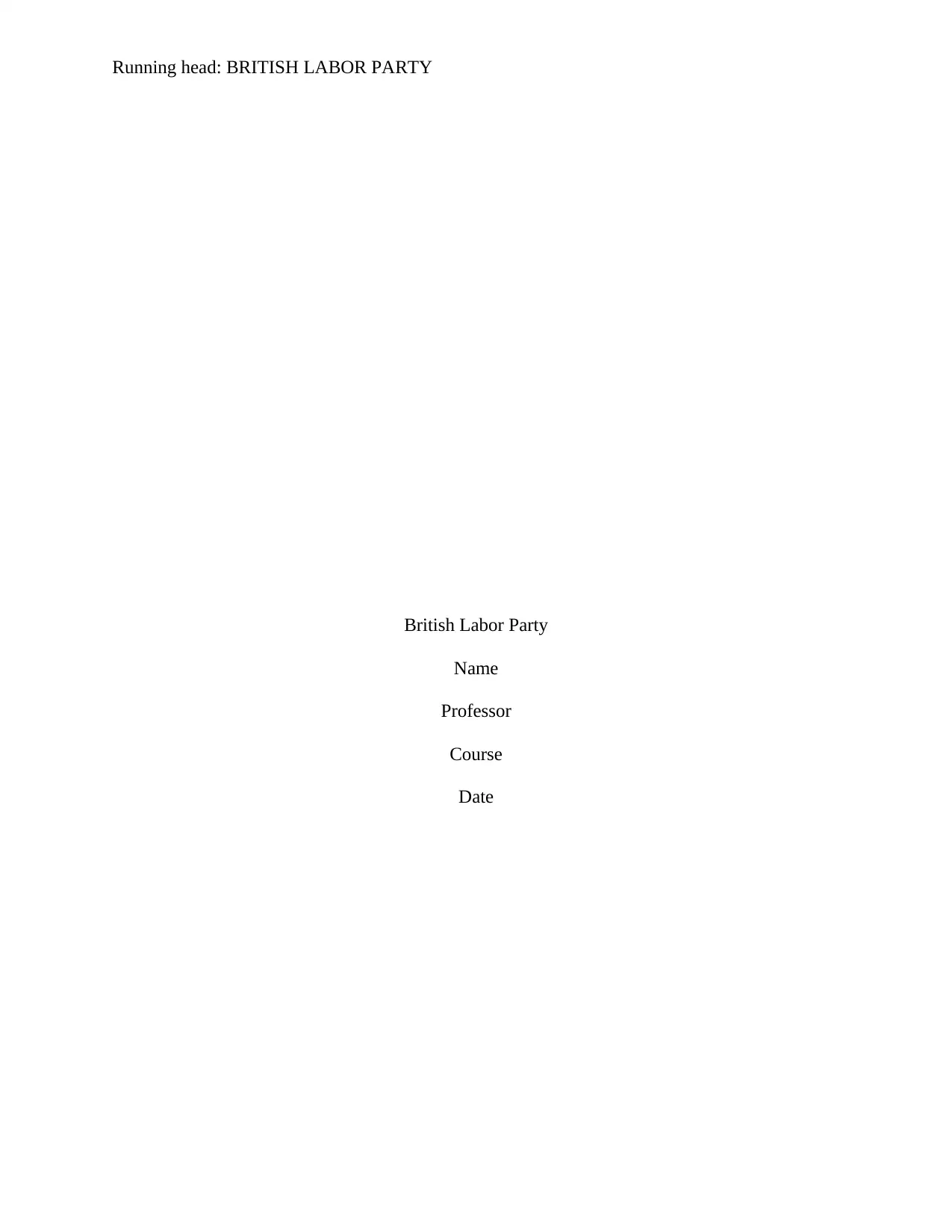
Running head: BRITISH LABOR PARTY
British Labor Party
Name
Professor
Course
Date
British Labor Party
Name
Professor
Course
Date
Secure Best Marks with AI Grader
Need help grading? Try our AI Grader for instant feedback on your assignments.
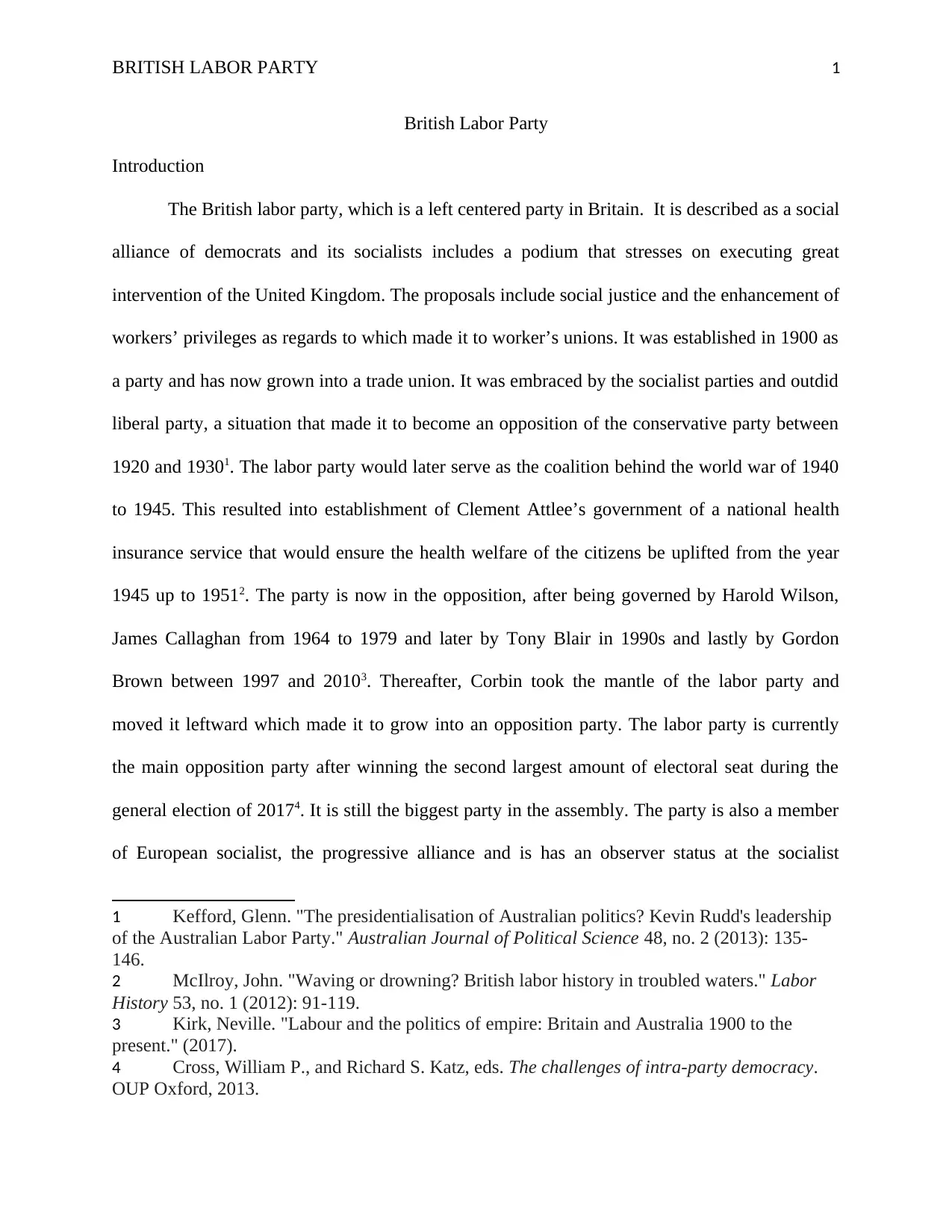
BRITISH LABOR PARTY 1
British Labor Party
Introduction
The British labor party, which is a left centered party in Britain. It is described as a social
alliance of democrats and its socialists includes a podium that stresses on executing great
intervention of the United Kingdom. The proposals include social justice and the enhancement of
workers’ privileges as regards to which made it to worker’s unions. It was established in 1900 as
a party and has now grown into a trade union. It was embraced by the socialist parties and outdid
liberal party, a situation that made it to become an opposition of the conservative party between
1920 and 19301. The labor party would later serve as the coalition behind the world war of 1940
to 1945. This resulted into establishment of Clement Attlee’s government of a national health
insurance service that would ensure the health welfare of the citizens be uplifted from the year
1945 up to 19512. The party is now in the opposition, after being governed by Harold Wilson,
James Callaghan from 1964 to 1979 and later by Tony Blair in 1990s and lastly by Gordon
Brown between 1997 and 20103. Thereafter, Corbin took the mantle of the labor party and
moved it leftward which made it to grow into an opposition party. The labor party is currently
the main opposition party after winning the second largest amount of electoral seat during the
general election of 20174. It is still the biggest party in the assembly. The party is also a member
of European socialist, the progressive alliance and is has an observer status at the socialist
1 Kefford, Glenn. "The presidentialisation of Australian politics? Kevin Rudd's leadership
of the Australian Labor Party." Australian Journal of Political Science 48, no. 2 (2013): 135-
146.
2 McIlroy, John. "Waving or drowning? British labor history in troubled waters." Labor
History 53, no. 1 (2012): 91-119.
3 Kirk, Neville. "Labour and the politics of empire: Britain and Australia 1900 to the
present." (2017).
4 Cross, William P., and Richard S. Katz, eds. The challenges of intra-party democracy.
OUP Oxford, 2013.
British Labor Party
Introduction
The British labor party, which is a left centered party in Britain. It is described as a social
alliance of democrats and its socialists includes a podium that stresses on executing great
intervention of the United Kingdom. The proposals include social justice and the enhancement of
workers’ privileges as regards to which made it to worker’s unions. It was established in 1900 as
a party and has now grown into a trade union. It was embraced by the socialist parties and outdid
liberal party, a situation that made it to become an opposition of the conservative party between
1920 and 19301. The labor party would later serve as the coalition behind the world war of 1940
to 1945. This resulted into establishment of Clement Attlee’s government of a national health
insurance service that would ensure the health welfare of the citizens be uplifted from the year
1945 up to 19512. The party is now in the opposition, after being governed by Harold Wilson,
James Callaghan from 1964 to 1979 and later by Tony Blair in 1990s and lastly by Gordon
Brown between 1997 and 20103. Thereafter, Corbin took the mantle of the labor party and
moved it leftward which made it to grow into an opposition party. The labor party is currently
the main opposition party after winning the second largest amount of electoral seat during the
general election of 20174. It is still the biggest party in the assembly. The party is also a member
of European socialist, the progressive alliance and is has an observer status at the socialist
1 Kefford, Glenn. "The presidentialisation of Australian politics? Kevin Rudd's leadership
of the Australian Labor Party." Australian Journal of Political Science 48, no. 2 (2013): 135-
146.
2 McIlroy, John. "Waving or drowning? British labor history in troubled waters." Labor
History 53, no. 1 (2012): 91-119.
3 Kirk, Neville. "Labour and the politics of empire: Britain and Australia 1900 to the
present." (2017).
4 Cross, William P., and Richard S. Katz, eds. The challenges of intra-party democracy.
OUP Oxford, 2013.
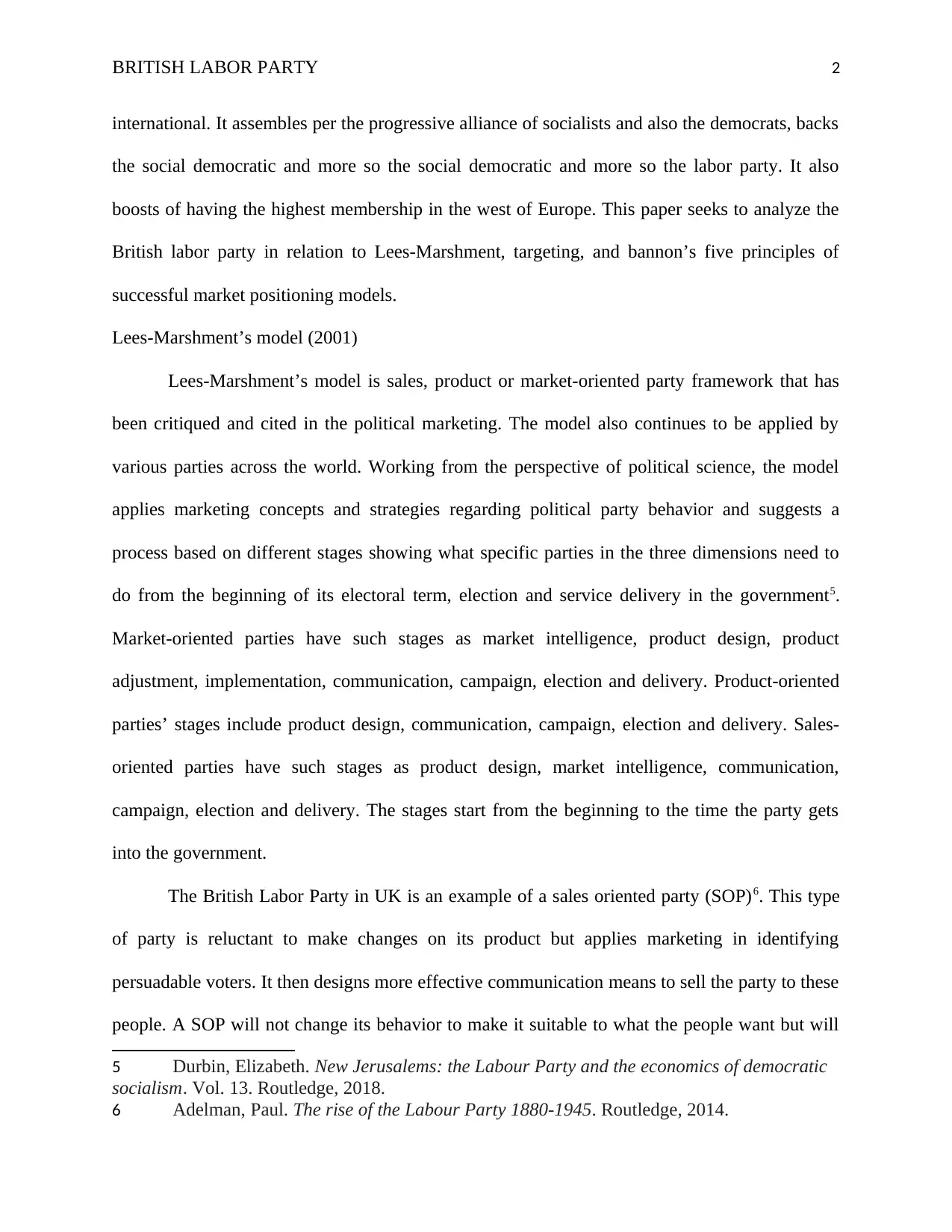
BRITISH LABOR PARTY 2
international. It assembles per the progressive alliance of socialists and also the democrats, backs
the social democratic and more so the social democratic and more so the labor party. It also
boosts of having the highest membership in the west of Europe. This paper seeks to analyze the
British labor party in relation to Lees-Marshment, targeting, and bannon’s five principles of
successful market positioning models.
Lees-Marshment’s model (2001)
Lees-Marshment’s model is sales, product or market-oriented party framework that has
been critiqued and cited in the political marketing. The model also continues to be applied by
various parties across the world. Working from the perspective of political science, the model
applies marketing concepts and strategies regarding political party behavior and suggests a
process based on different stages showing what specific parties in the three dimensions need to
do from the beginning of its electoral term, election and service delivery in the government5.
Market-oriented parties have such stages as market intelligence, product design, product
adjustment, implementation, communication, campaign, election and delivery. Product-oriented
parties’ stages include product design, communication, campaign, election and delivery. Sales-
oriented parties have such stages as product design, market intelligence, communication,
campaign, election and delivery. The stages start from the beginning to the time the party gets
into the government.
The British Labor Party in UK is an example of a sales oriented party (SOP)6. This type
of party is reluctant to make changes on its product but applies marketing in identifying
persuadable voters. It then designs more effective communication means to sell the party to these
people. A SOP will not change its behavior to make it suitable to what the people want but will
5 Durbin, Elizabeth. New Jerusalems: the Labour Party and the economics of democratic
socialism. Vol. 13. Routledge, 2018.
6 Adelman, Paul. The rise of the Labour Party 1880-1945. Routledge, 2014.
international. It assembles per the progressive alliance of socialists and also the democrats, backs
the social democratic and more so the social democratic and more so the labor party. It also
boosts of having the highest membership in the west of Europe. This paper seeks to analyze the
British labor party in relation to Lees-Marshment, targeting, and bannon’s five principles of
successful market positioning models.
Lees-Marshment’s model (2001)
Lees-Marshment’s model is sales, product or market-oriented party framework that has
been critiqued and cited in the political marketing. The model also continues to be applied by
various parties across the world. Working from the perspective of political science, the model
applies marketing concepts and strategies regarding political party behavior and suggests a
process based on different stages showing what specific parties in the three dimensions need to
do from the beginning of its electoral term, election and service delivery in the government5.
Market-oriented parties have such stages as market intelligence, product design, product
adjustment, implementation, communication, campaign, election and delivery. Product-oriented
parties’ stages include product design, communication, campaign, election and delivery. Sales-
oriented parties have such stages as product design, market intelligence, communication,
campaign, election and delivery. The stages start from the beginning to the time the party gets
into the government.
The British Labor Party in UK is an example of a sales oriented party (SOP)6. This type
of party is reluctant to make changes on its product but applies marketing in identifying
persuadable voters. It then designs more effective communication means to sell the party to these
people. A SOP will not change its behavior to make it suitable to what the people want but will
5 Durbin, Elizabeth. New Jerusalems: the Labour Party and the economics of democratic
socialism. Vol. 13. Routledge, 2018.
6 Adelman, Paul. The rise of the Labour Party 1880-1945. Routledge, 2014.

BRITISH LABOR PARTY 3
try to make the people like what the party offers. It uses market intelligence in understanding the
response of the voters to its behavior. This is done by making use of the latest communication
and advertising techniques in persuading the people that it is the right one. In 1992, the labor
party leader Neil Kinnock was elected to appease the party’s left wing and unite the members but
he lacked a wide electoral appeal7. Several other weaknesses in the party product were evident
including the unpopular policies in the party manifesto such as the unilateralist defense policy,
state ownership expansion and economy intervention. The party’s image was also poor regarding
economic management and strong links in the party with unions.
However, they were able to show significant effort in the communication stage. They
recruited staff with professional expertise to reorganize the communication strategies. They
appointed a new advertising agency and adopted a new party symbol of a rose. They appointed
MORI to help in conducting surveys panel study and polling, which targeted marginal seats and
particular groups to inform the campaign design. However, the party lost with the polls showing
that there was public dissatisfaction with its product. What the party had done was to use
marketing in informing the communication instead of designing the product well enough. Had
the party applied a well design on its product like it did in 1924 and 1929 when it won and got
into the government, it would remain there for long8. This cost the party by losing the elections
to the independent labor party that had been restructuring its strategies since the past. It is
always recommended that any political party be aware of what strategies are being applied by the
opponent parties so that they can make sure that whatever dimension is being applied, is done
perfectly for it to get to the government.
7 Ormrod, Robert P. "Limitations and implications of product‐oriented, sales‐oriented and
market‐oriented political parties: evidence for public affairs." Journal of Public Affairs 11, no. 4
(2011): 395-405.
8 Johns, Robert, and Heinz Brandenburg. "Giving voters what they want? Party orientation
perceptions and preferences in the British electorate." Party Politics 20, no. 1 (2014): 89-104.
try to make the people like what the party offers. It uses market intelligence in understanding the
response of the voters to its behavior. This is done by making use of the latest communication
and advertising techniques in persuading the people that it is the right one. In 1992, the labor
party leader Neil Kinnock was elected to appease the party’s left wing and unite the members but
he lacked a wide electoral appeal7. Several other weaknesses in the party product were evident
including the unpopular policies in the party manifesto such as the unilateralist defense policy,
state ownership expansion and economy intervention. The party’s image was also poor regarding
economic management and strong links in the party with unions.
However, they were able to show significant effort in the communication stage. They
recruited staff with professional expertise to reorganize the communication strategies. They
appointed a new advertising agency and adopted a new party symbol of a rose. They appointed
MORI to help in conducting surveys panel study and polling, which targeted marginal seats and
particular groups to inform the campaign design. However, the party lost with the polls showing
that there was public dissatisfaction with its product. What the party had done was to use
marketing in informing the communication instead of designing the product well enough. Had
the party applied a well design on its product like it did in 1924 and 1929 when it won and got
into the government, it would remain there for long8. This cost the party by losing the elections
to the independent labor party that had been restructuring its strategies since the past. It is
always recommended that any political party be aware of what strategies are being applied by the
opponent parties so that they can make sure that whatever dimension is being applied, is done
perfectly for it to get to the government.
7 Ormrod, Robert P. "Limitations and implications of product‐oriented, sales‐oriented and
market‐oriented political parties: evidence for public affairs." Journal of Public Affairs 11, no. 4
(2011): 395-405.
8 Johns, Robert, and Heinz Brandenburg. "Giving voters what they want? Party orientation
perceptions and preferences in the British electorate." Party Politics 20, no. 1 (2014): 89-104.
Secure Best Marks with AI Grader
Need help grading? Try our AI Grader for instant feedback on your assignments.
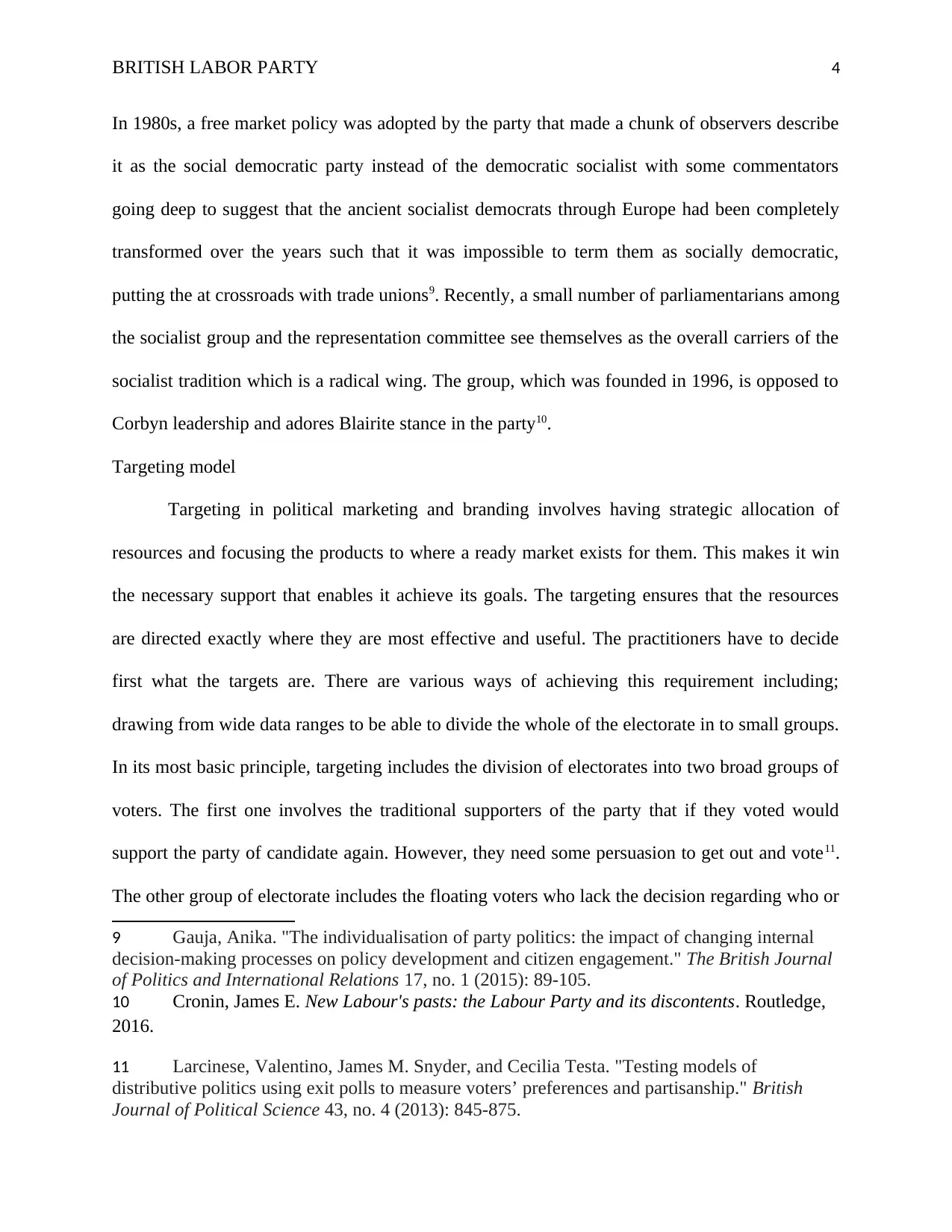
BRITISH LABOR PARTY 4
In 1980s, a free market policy was adopted by the party that made a chunk of observers describe
it as the social democratic party instead of the democratic socialist with some commentators
going deep to suggest that the ancient socialist democrats through Europe had been completely
transformed over the years such that it was impossible to term them as socially democratic,
putting the at crossroads with trade unions9. Recently, a small number of parliamentarians among
the socialist group and the representation committee see themselves as the overall carriers of the
socialist tradition which is a radical wing. The group, which was founded in 1996, is opposed to
Corbyn leadership and adores Blairite stance in the party10.
Targeting model
Targeting in political marketing and branding involves having strategic allocation of
resources and focusing the products to where a ready market exists for them. This makes it win
the necessary support that enables it achieve its goals. The targeting ensures that the resources
are directed exactly where they are most effective and useful. The practitioners have to decide
first what the targets are. There are various ways of achieving this requirement including;
drawing from wide data ranges to be able to divide the whole of the electorate in to small groups.
In its most basic principle, targeting includes the division of electorates into two broad groups of
voters. The first one involves the traditional supporters of the party that if they voted would
support the party of candidate again. However, they need some persuasion to get out and vote11.
The other group of electorate includes the floating voters who lack the decision regarding who or
9 Gauja, Anika. "The individualisation of party politics: the impact of changing internal
decision-making processes on policy development and citizen engagement." The British Journal
of Politics and International Relations 17, no. 1 (2015): 89-105.
10 Cronin, James E. New Labour's pasts: the Labour Party and its discontents. Routledge,
2016.
11 Larcinese, Valentino, James M. Snyder, and Cecilia Testa. "Testing models of
distributive politics using exit polls to measure voters’ preferences and partisanship." British
Journal of Political Science 43, no. 4 (2013): 845-875.
In 1980s, a free market policy was adopted by the party that made a chunk of observers describe
it as the social democratic party instead of the democratic socialist with some commentators
going deep to suggest that the ancient socialist democrats through Europe had been completely
transformed over the years such that it was impossible to term them as socially democratic,
putting the at crossroads with trade unions9. Recently, a small number of parliamentarians among
the socialist group and the representation committee see themselves as the overall carriers of the
socialist tradition which is a radical wing. The group, which was founded in 1996, is opposed to
Corbyn leadership and adores Blairite stance in the party10.
Targeting model
Targeting in political marketing and branding involves having strategic allocation of
resources and focusing the products to where a ready market exists for them. This makes it win
the necessary support that enables it achieve its goals. The targeting ensures that the resources
are directed exactly where they are most effective and useful. The practitioners have to decide
first what the targets are. There are various ways of achieving this requirement including;
drawing from wide data ranges to be able to divide the whole of the electorate in to small groups.
In its most basic principle, targeting includes the division of electorates into two broad groups of
voters. The first one involves the traditional supporters of the party that if they voted would
support the party of candidate again. However, they need some persuasion to get out and vote11.
The other group of electorate includes the floating voters who lack the decision regarding who or
9 Gauja, Anika. "The individualisation of party politics: the impact of changing internal
decision-making processes on policy development and citizen engagement." The British Journal
of Politics and International Relations 17, no. 1 (2015): 89-105.
10 Cronin, James E. New Labour's pasts: the Labour Party and its discontents. Routledge,
2016.
11 Larcinese, Valentino, James M. Snyder, and Cecilia Testa. "Testing models of
distributive politics using exit polls to measure voters’ preferences and partisanship." British
Journal of Political Science 43, no. 4 (2013): 845-875.
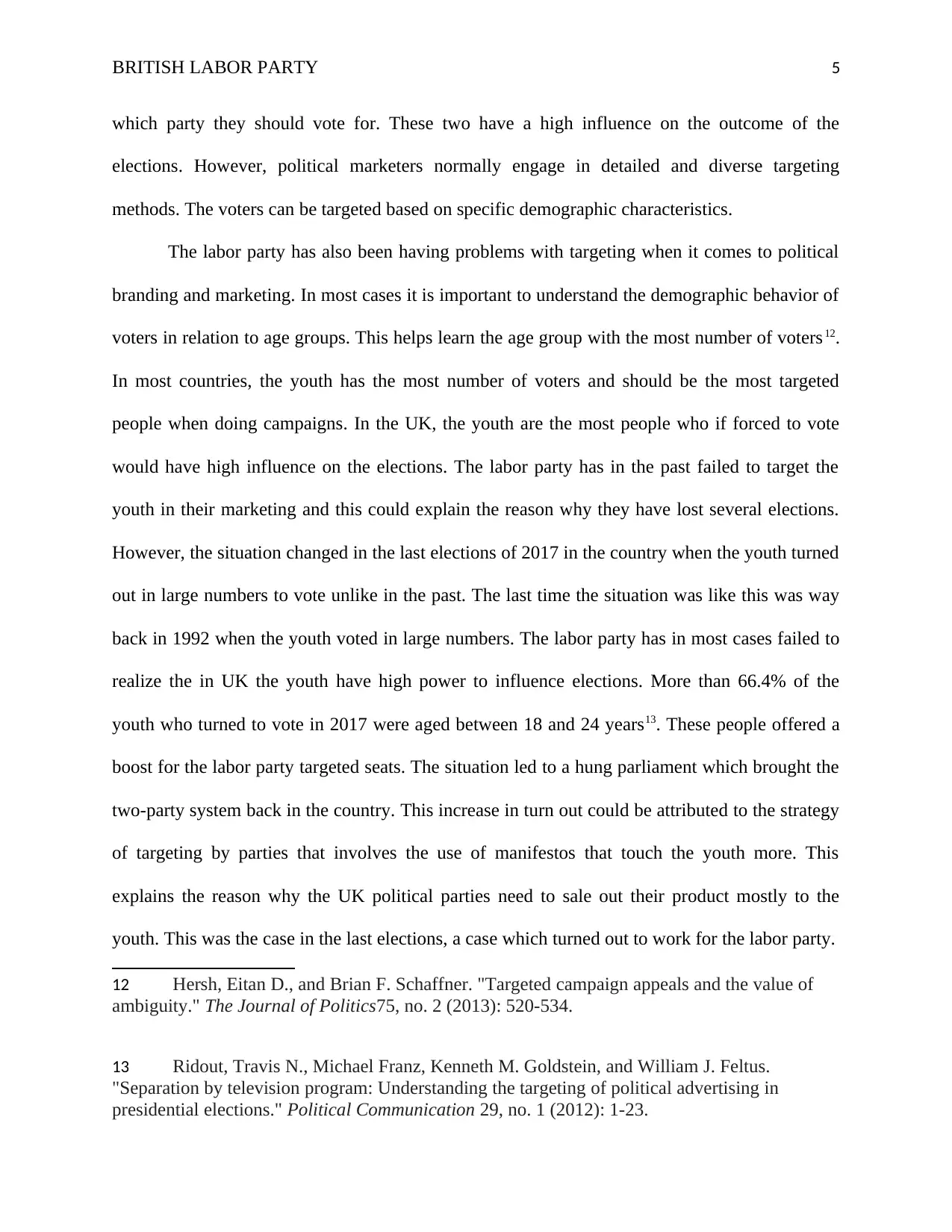
BRITISH LABOR PARTY 5
which party they should vote for. These two have a high influence on the outcome of the
elections. However, political marketers normally engage in detailed and diverse targeting
methods. The voters can be targeted based on specific demographic characteristics.
The labor party has also been having problems with targeting when it comes to political
branding and marketing. In most cases it is important to understand the demographic behavior of
voters in relation to age groups. This helps learn the age group with the most number of voters12.
In most countries, the youth has the most number of voters and should be the most targeted
people when doing campaigns. In the UK, the youth are the most people who if forced to vote
would have high influence on the elections. The labor party has in the past failed to target the
youth in their marketing and this could explain the reason why they have lost several elections.
However, the situation changed in the last elections of 2017 in the country when the youth turned
out in large numbers to vote unlike in the past. The last time the situation was like this was way
back in 1992 when the youth voted in large numbers. The labor party has in most cases failed to
realize the in UK the youth have high power to influence elections. More than 66.4% of the
youth who turned to vote in 2017 were aged between 18 and 24 years13. These people offered a
boost for the labor party targeted seats. The situation led to a hung parliament which brought the
two-party system back in the country. This increase in turn out could be attributed to the strategy
of targeting by parties that involves the use of manifestos that touch the youth more. This
explains the reason why the UK political parties need to sale out their product mostly to the
youth. This was the case in the last elections, a case which turned out to work for the labor party.
12 Hersh, Eitan D., and Brian F. Schaffner. "Targeted campaign appeals and the value of
ambiguity." The Journal of Politics75, no. 2 (2013): 520-534.
13 Ridout, Travis N., Michael Franz, Kenneth M. Goldstein, and William J. Feltus.
"Separation by television program: Understanding the targeting of political advertising in
presidential elections." Political Communication 29, no. 1 (2012): 1-23.
which party they should vote for. These two have a high influence on the outcome of the
elections. However, political marketers normally engage in detailed and diverse targeting
methods. The voters can be targeted based on specific demographic characteristics.
The labor party has also been having problems with targeting when it comes to political
branding and marketing. In most cases it is important to understand the demographic behavior of
voters in relation to age groups. This helps learn the age group with the most number of voters12.
In most countries, the youth has the most number of voters and should be the most targeted
people when doing campaigns. In the UK, the youth are the most people who if forced to vote
would have high influence on the elections. The labor party has in the past failed to target the
youth in their marketing and this could explain the reason why they have lost several elections.
However, the situation changed in the last elections of 2017 in the country when the youth turned
out in large numbers to vote unlike in the past. The last time the situation was like this was way
back in 1992 when the youth voted in large numbers. The labor party has in most cases failed to
realize the in UK the youth have high power to influence elections. More than 66.4% of the
youth who turned to vote in 2017 were aged between 18 and 24 years13. These people offered a
boost for the labor party targeted seats. The situation led to a hung parliament which brought the
two-party system back in the country. This increase in turn out could be attributed to the strategy
of targeting by parties that involves the use of manifestos that touch the youth more. This
explains the reason why the UK political parties need to sale out their product mostly to the
youth. This was the case in the last elections, a case which turned out to work for the labor party.
12 Hersh, Eitan D., and Brian F. Schaffner. "Targeted campaign appeals and the value of
ambiguity." The Journal of Politics75, no. 2 (2013): 520-534.
13 Ridout, Travis N., Michael Franz, Kenneth M. Goldstein, and William J. Feltus.
"Separation by television program: Understanding the targeting of political advertising in
presidential elections." Political Communication 29, no. 1 (2012): 1-23.
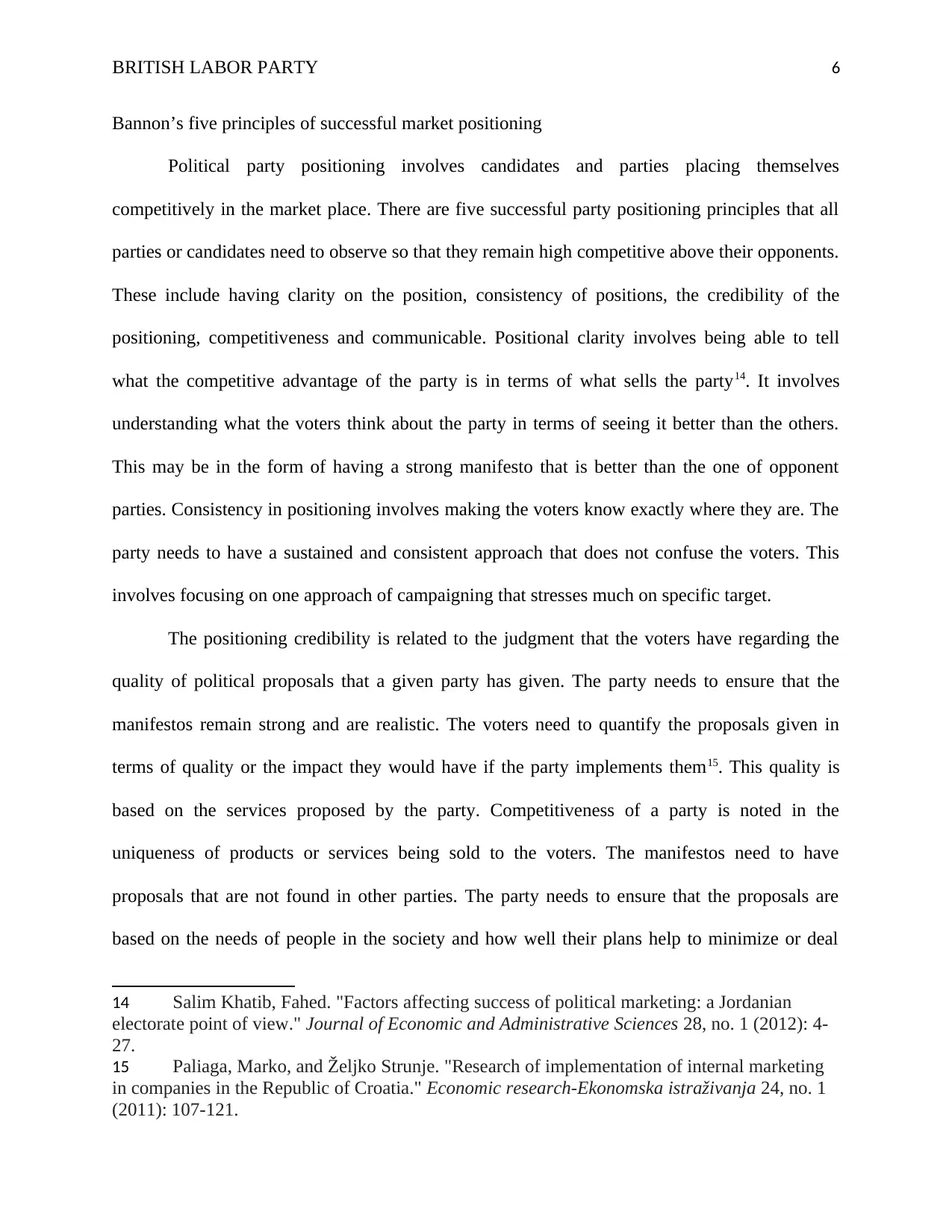
BRITISH LABOR PARTY 6
Bannon’s five principles of successful market positioning
Political party positioning involves candidates and parties placing themselves
competitively in the market place. There are five successful party positioning principles that all
parties or candidates need to observe so that they remain high competitive above their opponents.
These include having clarity on the position, consistency of positions, the credibility of the
positioning, competitiveness and communicable. Positional clarity involves being able to tell
what the competitive advantage of the party is in terms of what sells the party14. It involves
understanding what the voters think about the party in terms of seeing it better than the others.
This may be in the form of having a strong manifesto that is better than the one of opponent
parties. Consistency in positioning involves making the voters know exactly where they are. The
party needs to have a sustained and consistent approach that does not confuse the voters. This
involves focusing on one approach of campaigning that stresses much on specific target.
The positioning credibility is related to the judgment that the voters have regarding the
quality of political proposals that a given party has given. The party needs to ensure that the
manifestos remain strong and are realistic. The voters need to quantify the proposals given in
terms of quality or the impact they would have if the party implements them15. This quality is
based on the services proposed by the party. Competitiveness of a party is noted in the
uniqueness of products or services being sold to the voters. The manifestos need to have
proposals that are not found in other parties. The party needs to ensure that the proposals are
based on the needs of people in the society and how well their plans help to minimize or deal
14 Salim Khatib, Fahed. "Factors affecting success of political marketing: a Jordanian
electorate point of view." Journal of Economic and Administrative Sciences 28, no. 1 (2012): 4-
27.
15 Paliaga, Marko, and Željko Strunje. "Research of implementation of internal marketing
in companies in the Republic of Croatia." Economic research-Ekonomska istraživanja 24, no. 1
(2011): 107-121.
Bannon’s five principles of successful market positioning
Political party positioning involves candidates and parties placing themselves
competitively in the market place. There are five successful party positioning principles that all
parties or candidates need to observe so that they remain high competitive above their opponents.
These include having clarity on the position, consistency of positions, the credibility of the
positioning, competitiveness and communicable. Positional clarity involves being able to tell
what the competitive advantage of the party is in terms of what sells the party14. It involves
understanding what the voters think about the party in terms of seeing it better than the others.
This may be in the form of having a strong manifesto that is better than the one of opponent
parties. Consistency in positioning involves making the voters know exactly where they are. The
party needs to have a sustained and consistent approach that does not confuse the voters. This
involves focusing on one approach of campaigning that stresses much on specific target.
The positioning credibility is related to the judgment that the voters have regarding the
quality of political proposals that a given party has given. The party needs to ensure that the
manifestos remain strong and are realistic. The voters need to quantify the proposals given in
terms of quality or the impact they would have if the party implements them15. This quality is
based on the services proposed by the party. Competitiveness of a party is noted in the
uniqueness of products or services being sold to the voters. The manifestos need to have
proposals that are not found in other parties. The party needs to ensure that the proposals are
based on the needs of people in the society and how well their plans help to minimize or deal
14 Salim Khatib, Fahed. "Factors affecting success of political marketing: a Jordanian
electorate point of view." Journal of Economic and Administrative Sciences 28, no. 1 (2012): 4-
27.
15 Paliaga, Marko, and Željko Strunje. "Research of implementation of internal marketing
in companies in the Republic of Croatia." Economic research-Ekonomska istraživanja 24, no. 1
(2011): 107-121.
Paraphrase This Document
Need a fresh take? Get an instant paraphrase of this document with our AI Paraphraser
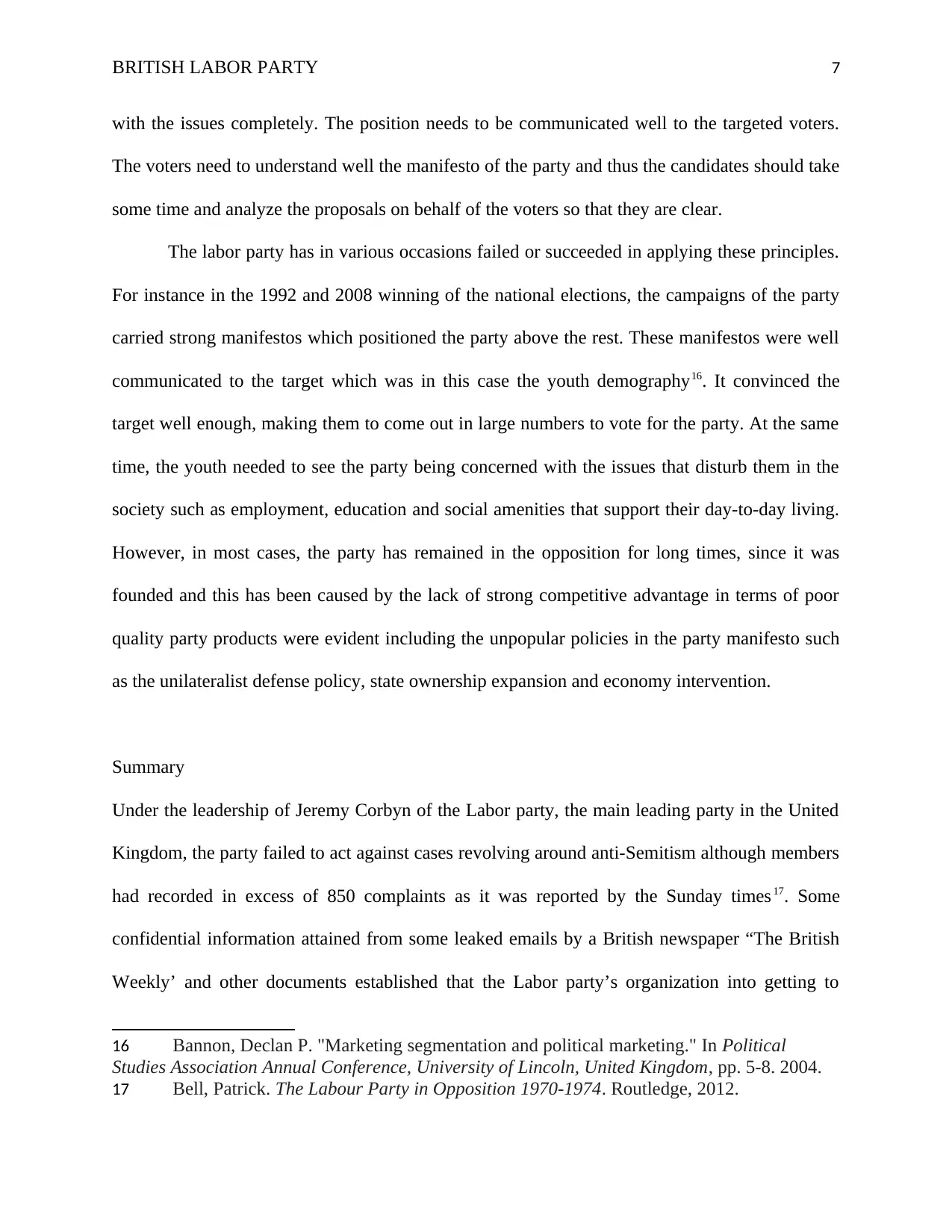
BRITISH LABOR PARTY 7
with the issues completely. The position needs to be communicated well to the targeted voters.
The voters need to understand well the manifesto of the party and thus the candidates should take
some time and analyze the proposals on behalf of the voters so that they are clear.
The labor party has in various occasions failed or succeeded in applying these principles.
For instance in the 1992 and 2008 winning of the national elections, the campaigns of the party
carried strong manifestos which positioned the party above the rest. These manifestos were well
communicated to the target which was in this case the youth demography16. It convinced the
target well enough, making them to come out in large numbers to vote for the party. At the same
time, the youth needed to see the party being concerned with the issues that disturb them in the
society such as employment, education and social amenities that support their day-to-day living.
However, in most cases, the party has remained in the opposition for long times, since it was
founded and this has been caused by the lack of strong competitive advantage in terms of poor
quality party products were evident including the unpopular policies in the party manifesto such
as the unilateralist defense policy, state ownership expansion and economy intervention.
Summary
Under the leadership of Jeremy Corbyn of the Labor party, the main leading party in the United
Kingdom, the party failed to act against cases revolving around anti-Semitism although members
had recorded in excess of 850 complaints as it was reported by the Sunday times17. Some
confidential information attained from some leaked emails by a British newspaper “The British
Weekly’ and other documents established that the Labor party’s organization into getting to
16 Bannon, Declan P. "Marketing segmentation and political marketing." In Political
Studies Association Annual Conference, University of Lincoln, United Kingdom, pp. 5-8. 2004.
17 Bell, Patrick. The Labour Party in Opposition 1970-1974. Routledge, 2012.
with the issues completely. The position needs to be communicated well to the targeted voters.
The voters need to understand well the manifesto of the party and thus the candidates should take
some time and analyze the proposals on behalf of the voters so that they are clear.
The labor party has in various occasions failed or succeeded in applying these principles.
For instance in the 1992 and 2008 winning of the national elections, the campaigns of the party
carried strong manifestos which positioned the party above the rest. These manifestos were well
communicated to the target which was in this case the youth demography16. It convinced the
target well enough, making them to come out in large numbers to vote for the party. At the same
time, the youth needed to see the party being concerned with the issues that disturb them in the
society such as employment, education and social amenities that support their day-to-day living.
However, in most cases, the party has remained in the opposition for long times, since it was
founded and this has been caused by the lack of strong competitive advantage in terms of poor
quality party products were evident including the unpopular policies in the party manifesto such
as the unilateralist defense policy, state ownership expansion and economy intervention.
Summary
Under the leadership of Jeremy Corbyn of the Labor party, the main leading party in the United
Kingdom, the party failed to act against cases revolving around anti-Semitism although members
had recorded in excess of 850 complaints as it was reported by the Sunday times17. Some
confidential information attained from some leaked emails by a British newspaper “The British
Weekly’ and other documents established that the Labor party’s organization into getting to
16 Bannon, Declan P. "Marketing segmentation and political marketing." In Political
Studies Association Annual Conference, University of Lincoln, United Kingdom, pp. 5-8. 2004.
17 Bell, Patrick. The Labour Party in Opposition 1970-1974. Routledge, 2012.
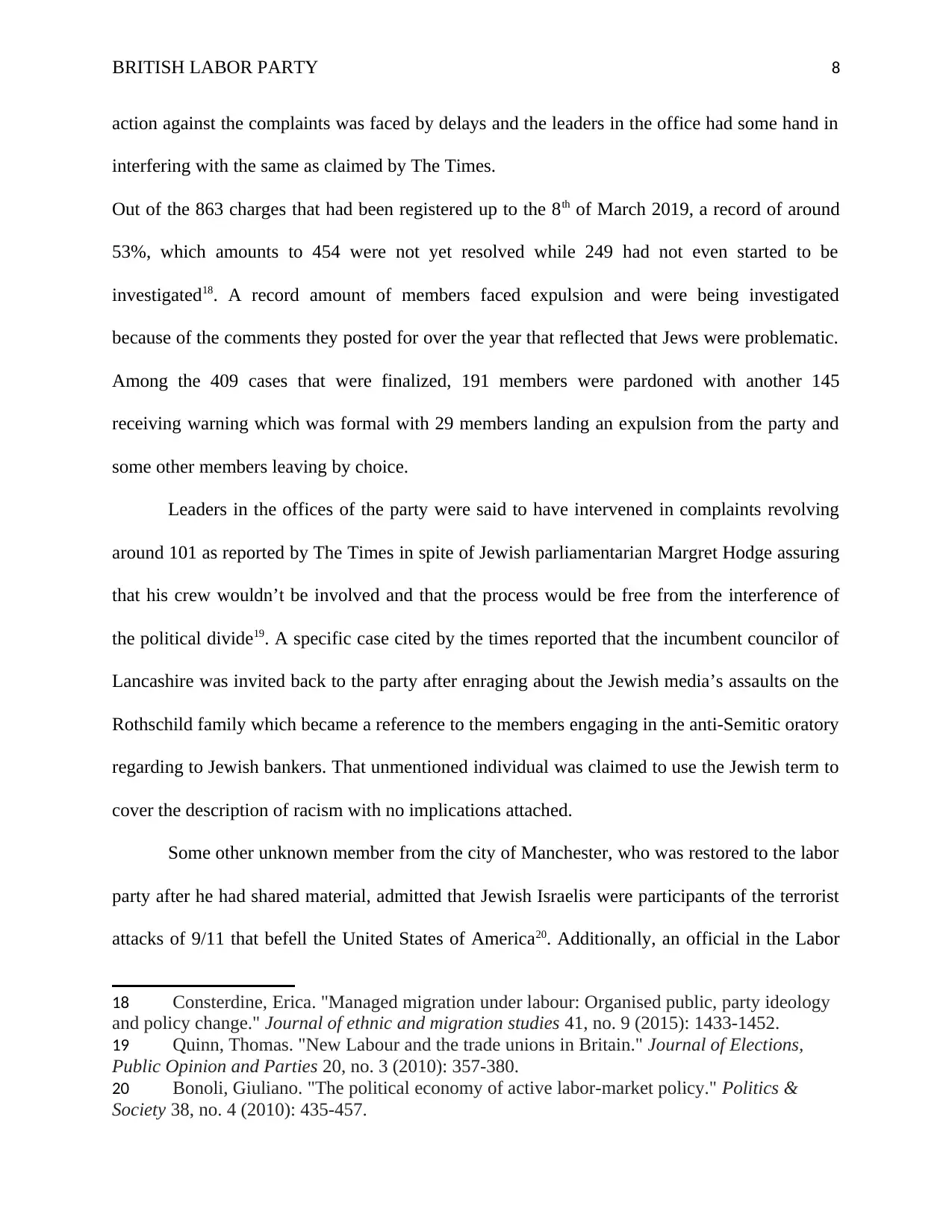
BRITISH LABOR PARTY 8
action against the complaints was faced by delays and the leaders in the office had some hand in
interfering with the same as claimed by The Times.
Out of the 863 charges that had been registered up to the 8th of March 2019, a record of around
53%, which amounts to 454 were not yet resolved while 249 had not even started to be
investigated18. A record amount of members faced expulsion and were being investigated
because of the comments they posted for over the year that reflected that Jews were problematic.
Among the 409 cases that were finalized, 191 members were pardoned with another 145
receiving warning which was formal with 29 members landing an expulsion from the party and
some other members leaving by choice.
Leaders in the offices of the party were said to have intervened in complaints revolving
around 101 as reported by The Times in spite of Jewish parliamentarian Margret Hodge assuring
that his crew wouldn’t be involved and that the process would be free from the interference of
the political divide19. A specific case cited by the times reported that the incumbent councilor of
Lancashire was invited back to the party after enraging about the Jewish media’s assaults on the
Rothschild family which became a reference to the members engaging in the anti-Semitic oratory
regarding to Jewish bankers. That unmentioned individual was claimed to use the Jewish term to
cover the description of racism with no implications attached.
Some other unknown member from the city of Manchester, who was restored to the labor
party after he had shared material, admitted that Jewish Israelis were participants of the terrorist
attacks of 9/11 that befell the United States of America20. Additionally, an official in the Labor
18 Consterdine, Erica. "Managed migration under labour: Organised public, party ideology
and policy change." Journal of ethnic and migration studies 41, no. 9 (2015): 1433-1452.
19 Quinn, Thomas. "New Labour and the trade unions in Britain." Journal of Elections,
Public Opinion and Parties 20, no. 3 (2010): 357-380.
20 Bonoli, Giuliano. "The political economy of active labor-market policy." Politics &
Society 38, no. 4 (2010): 435-457.
action against the complaints was faced by delays and the leaders in the office had some hand in
interfering with the same as claimed by The Times.
Out of the 863 charges that had been registered up to the 8th of March 2019, a record of around
53%, which amounts to 454 were not yet resolved while 249 had not even started to be
investigated18. A record amount of members faced expulsion and were being investigated
because of the comments they posted for over the year that reflected that Jews were problematic.
Among the 409 cases that were finalized, 191 members were pardoned with another 145
receiving warning which was formal with 29 members landing an expulsion from the party and
some other members leaving by choice.
Leaders in the offices of the party were said to have intervened in complaints revolving
around 101 as reported by The Times in spite of Jewish parliamentarian Margret Hodge assuring
that his crew wouldn’t be involved and that the process would be free from the interference of
the political divide19. A specific case cited by the times reported that the incumbent councilor of
Lancashire was invited back to the party after enraging about the Jewish media’s assaults on the
Rothschild family which became a reference to the members engaging in the anti-Semitic oratory
regarding to Jewish bankers. That unmentioned individual was claimed to use the Jewish term to
cover the description of racism with no implications attached.
Some other unknown member from the city of Manchester, who was restored to the labor
party after he had shared material, admitted that Jewish Israelis were participants of the terrorist
attacks of 9/11 that befell the United States of America20. Additionally, an official in the Labor
18 Consterdine, Erica. "Managed migration under labour: Organised public, party ideology
and policy change." Journal of ethnic and migration studies 41, no. 9 (2015): 1433-1452.
19 Quinn, Thomas. "New Labour and the trade unions in Britain." Journal of Elections,
Public Opinion and Parties 20, no. 3 (2010): 357-380.
20 Bonoli, Giuliano. "The political economy of active labor-market policy." Politics &
Society 38, no. 4 (2010): 435-457.

BRITISH LABOR PARTY 9
party alluded that a candidate of the council, of whom had accused the Jewish parliamentarian as
one of the ‘Zionist moles” was later pardoned against suspension because his candidature ruled
him out of disciplinary action and gave him the amnesty21.
Tom Watson, the deputy party leader of the Labor party while responding to the
exposures of the Sunday Times referred to it as “shocking and depressing” and that the labor
party had “not got to grips with it.” Adding that “Lines have been selectively leaked from emails
to misrepresent their overall contents,” In regard to this, the party now takes anti-Semitism
complaints enormously serious and commits itself to digging it out. Complaints are completely
investigated regarding the party’s rule and its procedures and do not comment where individual
cases are involved.
Subsequently, after Corbyn gained the party’s leadership in 2015, controversies arose in
sequences that related to the recurrent failure to dig out the mushrooming anti-Semitism in the
party and his pro-Palestinian rhetoric, a situation that led to frowsy engagement with the Jewish
community in Britain22. The Metropolitan police in London arrested some three people in March
upon its investigation towards the anti-Semitism posts in the media which were supposedly
coming from the members.
A controversy later shrouded Corbyn when a report erupted that a Palestinian center
occasion that happened in 2013 alluded that “Zionists” that reside in Britain had problems of not
appreciating history and more so, they don’t understand the irony of English23. Such comments
meant that “Zionists” and also was interpreted as “Jews” although they grew up in Britain did not
21 Beers, Laura. Your Britain: media and the making of the Labour party. Harvard
University Press, 2010.
22 Parkinson, Michael. The Labour Party and the Organization of Secondary Education
1918-65. Routledge, 2017.
23 Steinnes, Kristian. "The British Labour Party, Transnational Influences and European
Community Membership, 1960–1973." (2014).
party alluded that a candidate of the council, of whom had accused the Jewish parliamentarian as
one of the ‘Zionist moles” was later pardoned against suspension because his candidature ruled
him out of disciplinary action and gave him the amnesty21.
Tom Watson, the deputy party leader of the Labor party while responding to the
exposures of the Sunday Times referred to it as “shocking and depressing” and that the labor
party had “not got to grips with it.” Adding that “Lines have been selectively leaked from emails
to misrepresent their overall contents,” In regard to this, the party now takes anti-Semitism
complaints enormously serious and commits itself to digging it out. Complaints are completely
investigated regarding the party’s rule and its procedures and do not comment where individual
cases are involved.
Subsequently, after Corbyn gained the party’s leadership in 2015, controversies arose in
sequences that related to the recurrent failure to dig out the mushrooming anti-Semitism in the
party and his pro-Palestinian rhetoric, a situation that led to frowsy engagement with the Jewish
community in Britain22. The Metropolitan police in London arrested some three people in March
upon its investigation towards the anti-Semitism posts in the media which were supposedly
coming from the members.
A controversy later shrouded Corbyn when a report erupted that a Palestinian center
occasion that happened in 2013 alluded that “Zionists” that reside in Britain had problems of not
appreciating history and more so, they don’t understand the irony of English23. Such comments
meant that “Zionists” and also was interpreted as “Jews” although they grew up in Britain did not
21 Beers, Laura. Your Britain: media and the making of the Labour party. Harvard
University Press, 2010.
22 Parkinson, Michael. The Labour Party and the Organization of Secondary Education
1918-65. Routledge, 2017.
23 Steinnes, Kristian. "The British Labour Party, Transnational Influences and European
Community Membership, 1960–1973." (2014).
Secure Best Marks with AI Grader
Need help grading? Try our AI Grader for instant feedback on your assignments.

BRITISH LABOR PARTY 10
extensively understand the British thinking ways. Nine lawmakers of the Labour Party have quit
within some few months citing growing anti-Semitism within the party positions.
Recommendations
The party needs to focus on the proposals given during campaigns
They should amend its constitution to accommodate latest issues
It should remain a democratic party
They need to strengthen its manifestos based on socialism
They need to include the rights of workers
Summary
British labor party was formed for the purpose of trade union movement so as to form a
political establishment. It started a socialist engagement due to its constitution that it had
established in 1918. That status was regarded as its strongest and a good commitment towards
mutual possession and direct nationalization that would result into production, including
distribution and also an exchange. When the Second World War ended, almost a third of the
industries in Britain were reverted into public ownership, remaining public properties until
1980s24. Antony Crosland’s book “the future of socialism of 1959” inclined the lieutenants
around Hugh Gaitskell that figured that the party’s pledge not essential. Their resort into
abolishing clause IV of the party’s constitution in 1959 never materialize and Tony Blair saw the
situation as pulling out many the party’s would be voters25. The clause stated” The Labor Party is
a democratic socialist party. It believes that by the strength of our common endeavor we achieve
24 Salim Khatib, Fahed. "Factors affecting success of political marketing: a Jordanian
electorate point of view." Journal of Economic and Administrative Sciences 28, no. 1 (2012): 4-
27.
25 Gauja, Anika. "The individualisation of party politics: the impact of changing internal
decision-making processes on policy development and citizen engagement." The British Journal
of Politics and International Relations 17, no. 1 (2015): 89-105.
extensively understand the British thinking ways. Nine lawmakers of the Labour Party have quit
within some few months citing growing anti-Semitism within the party positions.
Recommendations
The party needs to focus on the proposals given during campaigns
They should amend its constitution to accommodate latest issues
It should remain a democratic party
They need to strengthen its manifestos based on socialism
They need to include the rights of workers
Summary
British labor party was formed for the purpose of trade union movement so as to form a
political establishment. It started a socialist engagement due to its constitution that it had
established in 1918. That status was regarded as its strongest and a good commitment towards
mutual possession and direct nationalization that would result into production, including
distribution and also an exchange. When the Second World War ended, almost a third of the
industries in Britain were reverted into public ownership, remaining public properties until
1980s24. Antony Crosland’s book “the future of socialism of 1959” inclined the lieutenants
around Hugh Gaitskell that figured that the party’s pledge not essential. Their resort into
abolishing clause IV of the party’s constitution in 1959 never materialize and Tony Blair saw the
situation as pulling out many the party’s would be voters25. The clause stated” The Labor Party is
a democratic socialist party. It believes that by the strength of our common endeavor we achieve
24 Salim Khatib, Fahed. "Factors affecting success of political marketing: a Jordanian
electorate point of view." Journal of Economic and Administrative Sciences 28, no. 1 (2012): 4-
27.
25 Gauja, Anika. "The individualisation of party politics: the impact of changing internal
decision-making processes on policy development and citizen engagement." The British Journal
of Politics and International Relations 17, no. 1 (2015): 89-105.
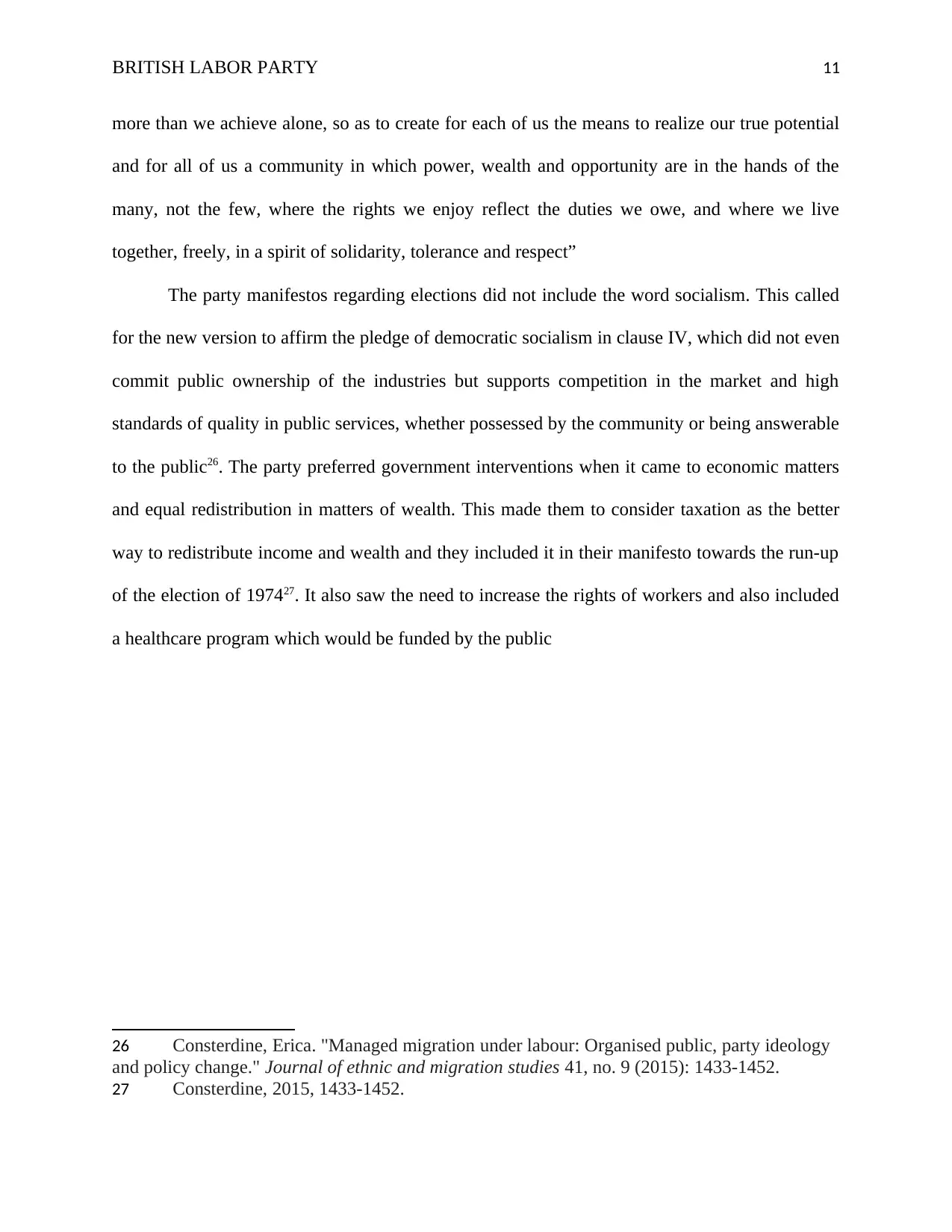
BRITISH LABOR PARTY 11
more than we achieve alone, so as to create for each of us the means to realize our true potential
and for all of us a community in which power, wealth and opportunity are in the hands of the
many, not the few, where the rights we enjoy reflect the duties we owe, and where we live
together, freely, in a spirit of solidarity, tolerance and respect”
The party manifestos regarding elections did not include the word socialism. This called
for the new version to affirm the pledge of democratic socialism in clause IV, which did not even
commit public ownership of the industries but supports competition in the market and high
standards of quality in public services, whether possessed by the community or being answerable
to the public26. The party preferred government interventions when it came to economic matters
and equal redistribution in matters of wealth. This made them to consider taxation as the better
way to redistribute income and wealth and they included it in their manifesto towards the run-up
of the election of 197427. It also saw the need to increase the rights of workers and also included
a healthcare program which would be funded by the public
26 Consterdine, Erica. "Managed migration under labour: Organised public, party ideology
and policy change." Journal of ethnic and migration studies 41, no. 9 (2015): 1433-1452.
27 Consterdine, 2015, 1433-1452.
more than we achieve alone, so as to create for each of us the means to realize our true potential
and for all of us a community in which power, wealth and opportunity are in the hands of the
many, not the few, where the rights we enjoy reflect the duties we owe, and where we live
together, freely, in a spirit of solidarity, tolerance and respect”
The party manifestos regarding elections did not include the word socialism. This called
for the new version to affirm the pledge of democratic socialism in clause IV, which did not even
commit public ownership of the industries but supports competition in the market and high
standards of quality in public services, whether possessed by the community or being answerable
to the public26. The party preferred government interventions when it came to economic matters
and equal redistribution in matters of wealth. This made them to consider taxation as the better
way to redistribute income and wealth and they included it in their manifesto towards the run-up
of the election of 197427. It also saw the need to increase the rights of workers and also included
a healthcare program which would be funded by the public
26 Consterdine, Erica. "Managed migration under labour: Organised public, party ideology
and policy change." Journal of ethnic and migration studies 41, no. 9 (2015): 1433-1452.
27 Consterdine, 2015, 1433-1452.
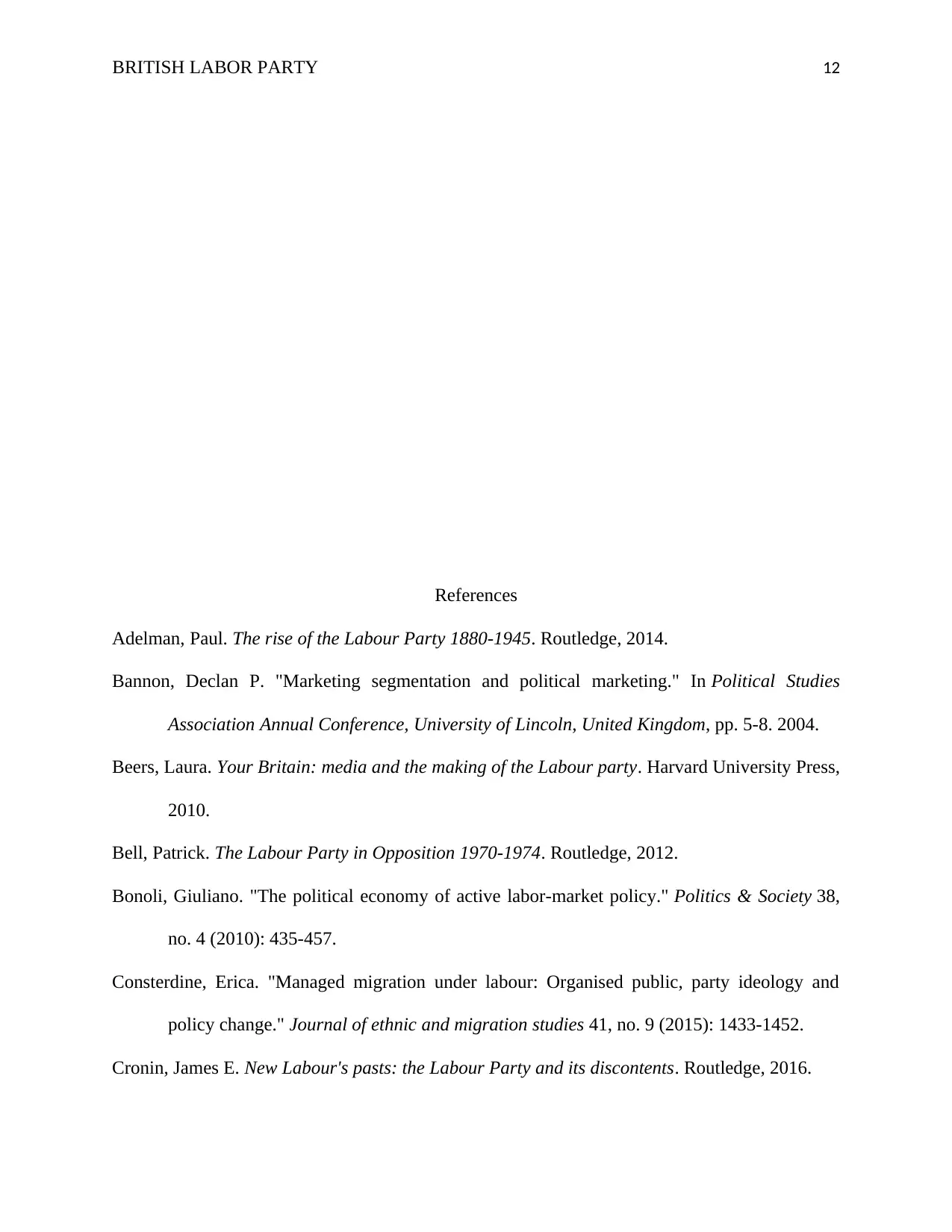
BRITISH LABOR PARTY 12
References
Adelman, Paul. The rise of the Labour Party 1880-1945. Routledge, 2014.
Bannon, Declan P. "Marketing segmentation and political marketing." In Political Studies
Association Annual Conference, University of Lincoln, United Kingdom, pp. 5-8. 2004.
Beers, Laura. Your Britain: media and the making of the Labour party. Harvard University Press,
2010.
Bell, Patrick. The Labour Party in Opposition 1970-1974. Routledge, 2012.
Bonoli, Giuliano. "The political economy of active labor-market policy." Politics & Society 38,
no. 4 (2010): 435-457.
Consterdine, Erica. "Managed migration under labour: Organised public, party ideology and
policy change." Journal of ethnic and migration studies 41, no. 9 (2015): 1433-1452.
Cronin, James E. New Labour's pasts: the Labour Party and its discontents. Routledge, 2016.
References
Adelman, Paul. The rise of the Labour Party 1880-1945. Routledge, 2014.
Bannon, Declan P. "Marketing segmentation and political marketing." In Political Studies
Association Annual Conference, University of Lincoln, United Kingdom, pp. 5-8. 2004.
Beers, Laura. Your Britain: media and the making of the Labour party. Harvard University Press,
2010.
Bell, Patrick. The Labour Party in Opposition 1970-1974. Routledge, 2012.
Bonoli, Giuliano. "The political economy of active labor-market policy." Politics & Society 38,
no. 4 (2010): 435-457.
Consterdine, Erica. "Managed migration under labour: Organised public, party ideology and
policy change." Journal of ethnic and migration studies 41, no. 9 (2015): 1433-1452.
Cronin, James E. New Labour's pasts: the Labour Party and its discontents. Routledge, 2016.
Paraphrase This Document
Need a fresh take? Get an instant paraphrase of this document with our AI Paraphraser
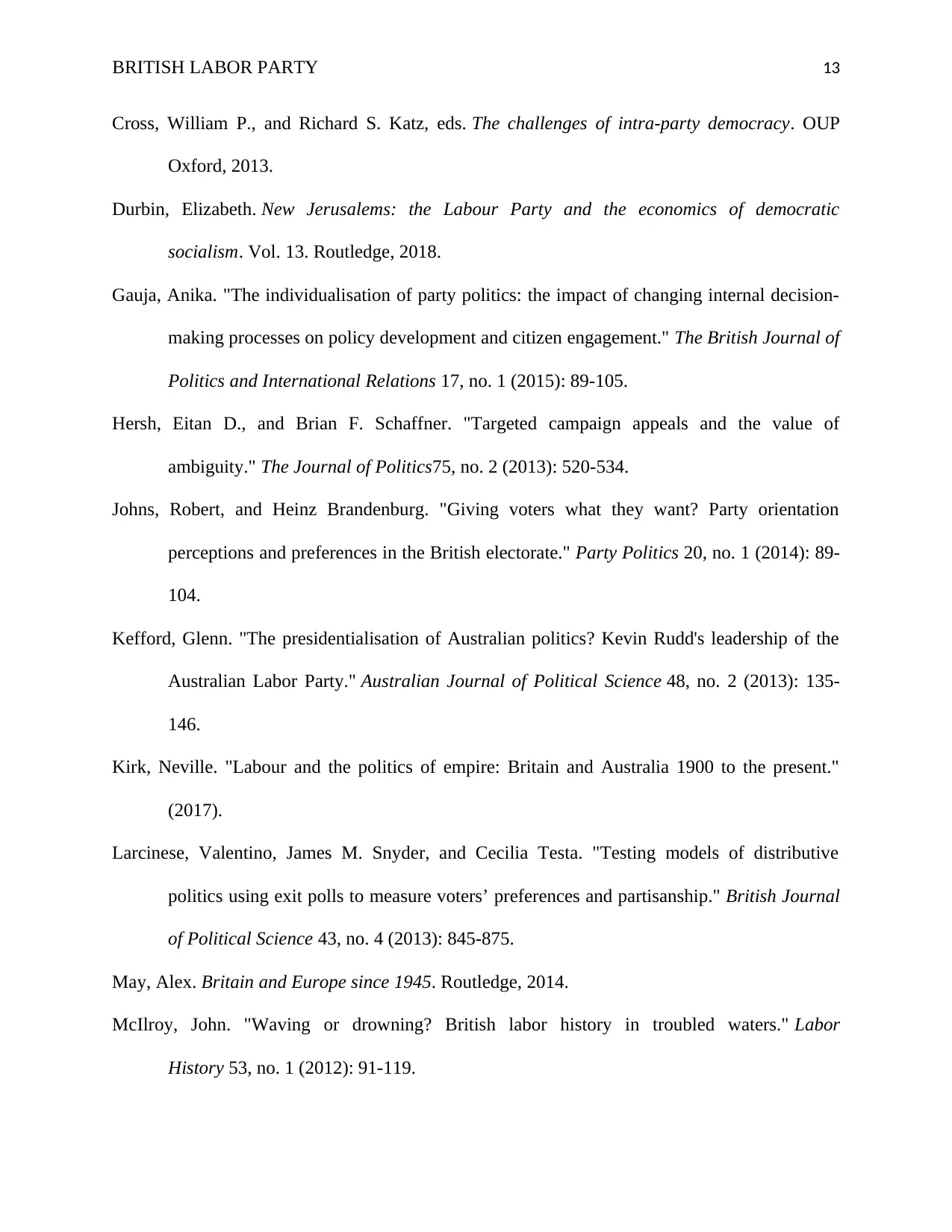
BRITISH LABOR PARTY 13
Cross, William P., and Richard S. Katz, eds. The challenges of intra-party democracy. OUP
Oxford, 2013.
Durbin, Elizabeth. New Jerusalems: the Labour Party and the economics of democratic
socialism. Vol. 13. Routledge, 2018.
Gauja, Anika. "The individualisation of party politics: the impact of changing internal decision-
making processes on policy development and citizen engagement." The British Journal of
Politics and International Relations 17, no. 1 (2015): 89-105.
Hersh, Eitan D., and Brian F. Schaffner. "Targeted campaign appeals and the value of
ambiguity." The Journal of Politics75, no. 2 (2013): 520-534.
Johns, Robert, and Heinz Brandenburg. "Giving voters what they want? Party orientation
perceptions and preferences in the British electorate." Party Politics 20, no. 1 (2014): 89-
104.
Kefford, Glenn. "The presidentialisation of Australian politics? Kevin Rudd's leadership of the
Australian Labor Party." Australian Journal of Political Science 48, no. 2 (2013): 135-
146.
Kirk, Neville. "Labour and the politics of empire: Britain and Australia 1900 to the present."
(2017).
Larcinese, Valentino, James M. Snyder, and Cecilia Testa. "Testing models of distributive
politics using exit polls to measure voters’ preferences and partisanship." British Journal
of Political Science 43, no. 4 (2013): 845-875.
May, Alex. Britain and Europe since 1945. Routledge, 2014.
McIlroy, John. "Waving or drowning? British labor history in troubled waters." Labor
History 53, no. 1 (2012): 91-119.
Cross, William P., and Richard S. Katz, eds. The challenges of intra-party democracy. OUP
Oxford, 2013.
Durbin, Elizabeth. New Jerusalems: the Labour Party and the economics of democratic
socialism. Vol. 13. Routledge, 2018.
Gauja, Anika. "The individualisation of party politics: the impact of changing internal decision-
making processes on policy development and citizen engagement." The British Journal of
Politics and International Relations 17, no. 1 (2015): 89-105.
Hersh, Eitan D., and Brian F. Schaffner. "Targeted campaign appeals and the value of
ambiguity." The Journal of Politics75, no. 2 (2013): 520-534.
Johns, Robert, and Heinz Brandenburg. "Giving voters what they want? Party orientation
perceptions and preferences in the British electorate." Party Politics 20, no. 1 (2014): 89-
104.
Kefford, Glenn. "The presidentialisation of Australian politics? Kevin Rudd's leadership of the
Australian Labor Party." Australian Journal of Political Science 48, no. 2 (2013): 135-
146.
Kirk, Neville. "Labour and the politics of empire: Britain and Australia 1900 to the present."
(2017).
Larcinese, Valentino, James M. Snyder, and Cecilia Testa. "Testing models of distributive
politics using exit polls to measure voters’ preferences and partisanship." British Journal
of Political Science 43, no. 4 (2013): 845-875.
May, Alex. Britain and Europe since 1945. Routledge, 2014.
McIlroy, John. "Waving or drowning? British labor history in troubled waters." Labor
History 53, no. 1 (2012): 91-119.

BRITISH LABOR PARTY 14
Ormrod, Robert P. "Limitations and implications of product‐oriented, sales‐oriented and market‐
oriented political parties: evidence for public affairs." Journal of Public Affairs 11, no. 4
(2011): 395-405.
Paliaga, Marko, and Željko Strunje. "Research of implementation of internal marketing in
companies in the Republic of Croatia." Economic research-Ekonomska istraživanja 24,
no. 1 (2011): 107-121.
Parkinson, Michael. The Labour Party and the Organization of Secondary Education 1918-65.
Routledge, 2017.
Quinn, Thomas. "New Labour and the trade unions in Britain." Journal of Elections, Public
Opinion and Parties 20, no. 3 (2010): 357-380.
Ridout, Travis N., Michael Franz, Kenneth M. Goldstein, and William J. Feltus. "Separation by
television program: Understanding the targeting of political advertising in presidential
elections." Political Communication 29, no. 1 (2012): 1-23.
Salim Khatib, Fahed. "Factors affecting success of political marketing: a Jordanian electorate
point of view." Journal of Economic and Administrative Sciences 28, no. 1 (2012): 4-27.
Steinnes, Kristian. "The British Labour Party, Transnational Influences and European
Community Membership, 1960–1973." (2014).
Ormrod, Robert P. "Limitations and implications of product‐oriented, sales‐oriented and market‐
oriented political parties: evidence for public affairs." Journal of Public Affairs 11, no. 4
(2011): 395-405.
Paliaga, Marko, and Željko Strunje. "Research of implementation of internal marketing in
companies in the Republic of Croatia." Economic research-Ekonomska istraživanja 24,
no. 1 (2011): 107-121.
Parkinson, Michael. The Labour Party and the Organization of Secondary Education 1918-65.
Routledge, 2017.
Quinn, Thomas. "New Labour and the trade unions in Britain." Journal of Elections, Public
Opinion and Parties 20, no. 3 (2010): 357-380.
Ridout, Travis N., Michael Franz, Kenneth M. Goldstein, and William J. Feltus. "Separation by
television program: Understanding the targeting of political advertising in presidential
elections." Political Communication 29, no. 1 (2012): 1-23.
Salim Khatib, Fahed. "Factors affecting success of political marketing: a Jordanian electorate
point of view." Journal of Economic and Administrative Sciences 28, no. 1 (2012): 4-27.
Steinnes, Kristian. "The British Labour Party, Transnational Influences and European
Community Membership, 1960–1973." (2014).
1 out of 15
Your All-in-One AI-Powered Toolkit for Academic Success.
+13062052269
info@desklib.com
Available 24*7 on WhatsApp / Email
![[object Object]](/_next/static/media/star-bottom.7253800d.svg)
Unlock your academic potential
© 2024 | Zucol Services PVT LTD | All rights reserved.